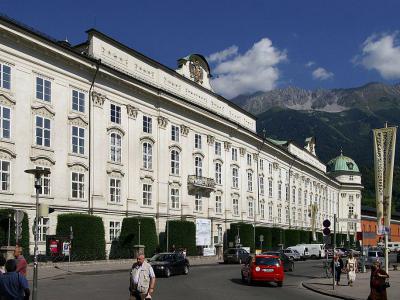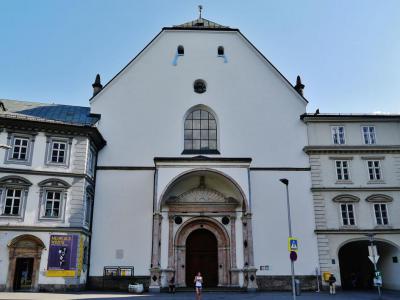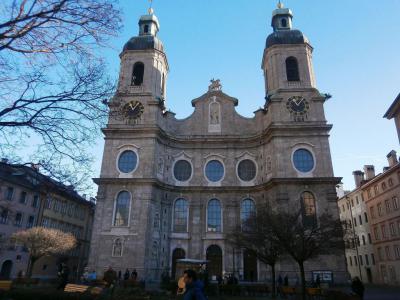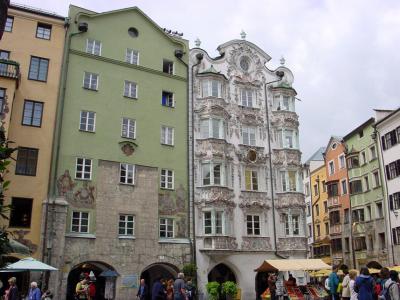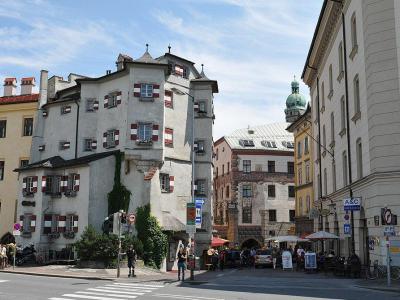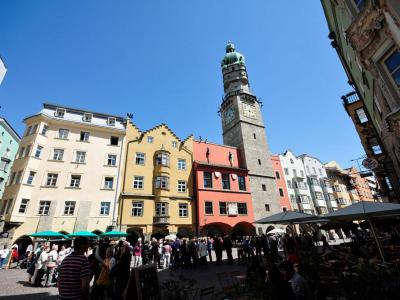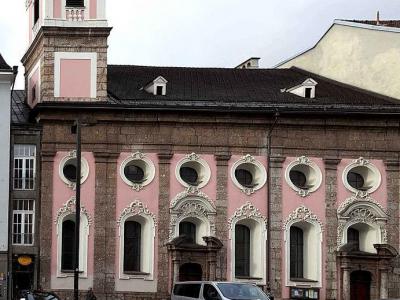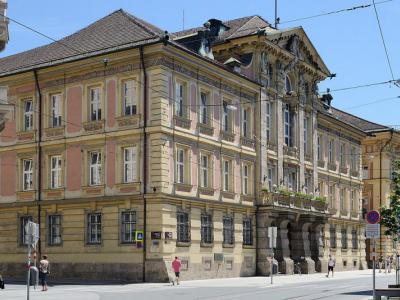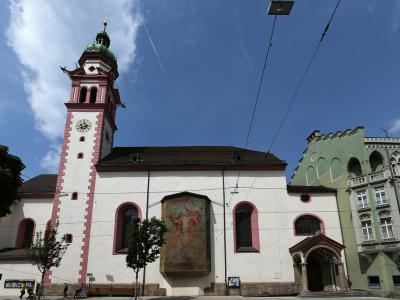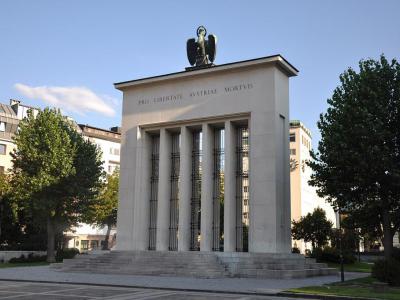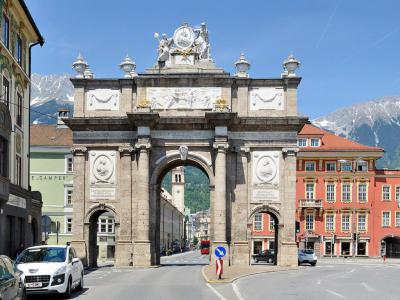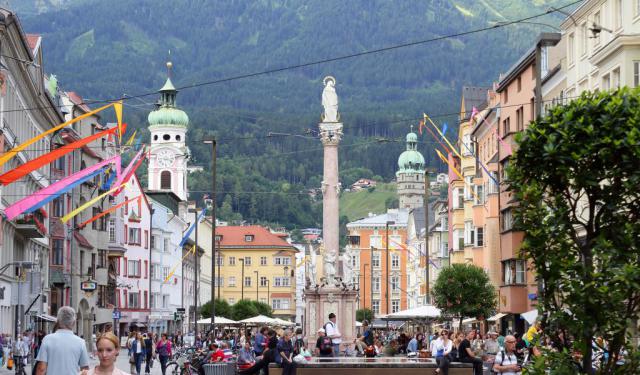Innsbruck's Architectural Jewels (Self Guided), Innsbruck
Coveted by empires, republics and ruling dynasties over the centuries, Innsbruck has been a living treasure house of history and culture. Undoubtedly this is one of Europe's most idyllic cities, nestled amid the craggy peaks in the heart of the Austrian Alps. Innsbruck equally scores as an Alpine playground and a showcase for Hapsburg imperial heritage, and is famous for its ancient, predominantly Gothic architecture, distinguished by its pointed arches, flying buttress, and ribbed vaults.
The majority of local buildings are old, some dating as far back as the 12th century. Architectural gems like the splendid Kaiserliche Hofburg (The Imperial Palace) lurk around every corner. Its worthwhile Giant’s Hall and Baroque Cellar give visitors a palpable sense of the elegance and wealth of the former Hapsburg Dynasty. Originally built by Archduke Sigmund the Rich in 1494, this is now an official residence of Austria’s president.
The nearby Gothic Hofkirche (Court Church), aka “Schwarzmanderkirche“ (Black Men's Church), houses the tomb of Emperor Maximilian I, and is one of Europe’s finest royal court churches; built from 1553 to 1563.
Ottoburg (Otto Castle) is an architectural landmark and one of Innsbruck’s most beloved restaurants, serving traditional Austrian cuisine.
Stadtturm (Town Tower) – this over 51-meter (150-feet) tall Gothic structure once formed part of the Old Town Hall, serving as an observation point.
Triumphpforte (Triumphal Arch) – an intricate construction built in celebration of Emperor Leopold I and Maria Ludovica of Spain’s engagement, which was shaded by a tragic passing of Emperor Franz Stephan I; hence the presence of joyful scenes on one end of the Arch and figures in mourning on the other.
To acquaint yourself more closely with these and other architectural jewels of Innsbruck, take our self-guided walking tour.
The majority of local buildings are old, some dating as far back as the 12th century. Architectural gems like the splendid Kaiserliche Hofburg (The Imperial Palace) lurk around every corner. Its worthwhile Giant’s Hall and Baroque Cellar give visitors a palpable sense of the elegance and wealth of the former Hapsburg Dynasty. Originally built by Archduke Sigmund the Rich in 1494, this is now an official residence of Austria’s president.
The nearby Gothic Hofkirche (Court Church), aka “Schwarzmanderkirche“ (Black Men's Church), houses the tomb of Emperor Maximilian I, and is one of Europe’s finest royal court churches; built from 1553 to 1563.
Ottoburg (Otto Castle) is an architectural landmark and one of Innsbruck’s most beloved restaurants, serving traditional Austrian cuisine.
Stadtturm (Town Tower) – this over 51-meter (150-feet) tall Gothic structure once formed part of the Old Town Hall, serving as an observation point.
Triumphpforte (Triumphal Arch) – an intricate construction built in celebration of Emperor Leopold I and Maria Ludovica of Spain’s engagement, which was shaded by a tragic passing of Emperor Franz Stephan I; hence the presence of joyful scenes on one end of the Arch and figures in mourning on the other.
To acquaint yourself more closely with these and other architectural jewels of Innsbruck, take our self-guided walking tour.
How it works: Download the app "GPSmyCity: Walks in 1K+ Cities" from Apple App Store or Google Play Store to your mobile phone or tablet. The app turns your mobile device into a personal tour guide and its built-in GPS navigation functions guide you from one tour stop to next. The app works offline, so no data plan is needed when traveling abroad.
Innsbruck's Architectural Jewels Map
Guide Name: Innsbruck's Architectural Jewels
Guide Location: Austria » Innsbruck (See other walking tours in Innsbruck)
Guide Type: Self-guided Walking Tour (Sightseeing)
# of Attractions: 11
Tour Duration: 1 Hour(s)
Travel Distance: 1.4 Km or 0.9 Miles
Author: irenes
Sight(s) Featured in This Guide:
Guide Location: Austria » Innsbruck (See other walking tours in Innsbruck)
Guide Type: Self-guided Walking Tour (Sightseeing)
# of Attractions: 11
Tour Duration: 1 Hour(s)
Travel Distance: 1.4 Km or 0.9 Miles
Author: irenes
Sight(s) Featured in This Guide:
- Kaiserliche Hofburg (Imperial Palace)
- Hofkirche (Court Church)
- Dom zu St. Jakob (St. Jakob Cathedral)
- Helblinghaus (Helbling House)
- Ottoburg (Otto Castle)
- Stadtturm (Town Tower)
- Spitalskirche (Hospital Church)
- Altes Landhaus (Old State House)
- Servitenkirche (Servite Church)
- Befreiungsdenkmal (Liberation Monument)
- Triumphpforte (Triumphal Arch)
1) Kaiserliche Hofburg (Imperial Palace) (must see)
For a long time the Innsbruck Imperial Palace was the home of the ruling Habsburg dynasty in Austria. It rates among the Imperial Palace and the Schonbrumm Palace in Vienna as one of the three most important cultural edifices in the country.
It was formerly a residential compound of the Habsburgs. It still houses the Noblewomen's Collegiate Foundation, the Silver Chapel, the Court Church with the cenotaph of Maximilion, the Theological University, The Tyrolean Folk Art Museum, Innsbruck Cathedral, the Congress and the Court Garden.
The palace was initially constructed from bits of medieval fortifications by Archduke Sigismund in 1460. There were several major changes over the next 250 years. Empress Maria Theresia made Baroque alterations.
The main facade on the Street Rennweg was completed and the Giants' Hall received ceiling frescoes. The Imperial Chapel was built in the room where Francis I had died in 1765. In 1858 the last renovation of the Imperial apartments was completed. The renovations followed the Rococo style of the Schonbrumm Palace in Vienna.
The Imperial Palace contains, not only the extensive Imperial Apartments. It also holds the Gothic Hall. The hall was built in 1494. It is a five nave hall with a cross-groined vault. The area of the hall is 2,133 square feet.
The Palace Courtyard is paved with cobblestones. It has an area of 4,265 square feet. It has been called "the most beautiful inner courtyard in Innsbruck." Redone Baroque style, it features elements of pilaster, frames, cornices and cartouches. There are four portals accessing the courtyard.
The Imperial Palace has two chapels that can be used for services and events.
It was formerly a residential compound of the Habsburgs. It still houses the Noblewomen's Collegiate Foundation, the Silver Chapel, the Court Church with the cenotaph of Maximilion, the Theological University, The Tyrolean Folk Art Museum, Innsbruck Cathedral, the Congress and the Court Garden.
The palace was initially constructed from bits of medieval fortifications by Archduke Sigismund in 1460. There were several major changes over the next 250 years. Empress Maria Theresia made Baroque alterations.
The main facade on the Street Rennweg was completed and the Giants' Hall received ceiling frescoes. The Imperial Chapel was built in the room where Francis I had died in 1765. In 1858 the last renovation of the Imperial apartments was completed. The renovations followed the Rococo style of the Schonbrumm Palace in Vienna.
The Imperial Palace contains, not only the extensive Imperial Apartments. It also holds the Gothic Hall. The hall was built in 1494. It is a five nave hall with a cross-groined vault. The area of the hall is 2,133 square feet.
The Palace Courtyard is paved with cobblestones. It has an area of 4,265 square feet. It has been called "the most beautiful inner courtyard in Innsbruck." Redone Baroque style, it features elements of pilaster, frames, cornices and cartouches. There are four portals accessing the courtyard.
The Imperial Palace has two chapels that can be used for services and events.
2) Hofkirche (Court Church) (must see)
Holy Roman Emperor Maximilion I (1459-1519) had become obsessed with the reality of death. He carried his coffin with him in his travels. A ruler who had pursued fame and glory with gusto all his life now thought mostly of his tomb. He was buried in the Saint George castle chapel in Vienna. His son, Charles V, and his grandson, Ferdinand I, financed the tomb project.
There was a catch. There wasn't enough room in the Saint George castle chapel for Maximilion and the tomb. Something had to give. No problem. Ferdinand built a monastery and tomb in Innsbruck, over 300 miles away. Maximilion stayed in Vienna.
The Innsbruck building was named Court Church ("Hofkirche" in German). The Court Church is next to the Imperial Palace (Hofburg). The design of the church is by Andrea Crivelli of Trento. It follows the plan of a German "hall church."
It has three naves, both round and pointed arch windows, and a hip roof. There is a blend of Renaissance designs and German Gothic styles. The portal is Renaissance, carved by Hieronymus de Longhi and Anton de Bol.
Inside there are galleries and thin red marble colonettes with white capitals. The vault is in 17th-century Baroque style. The high altar, designed by court architect Nikolas Pacassi, dates from 1755. There are statues of Francis of Assisi and Teresa of Avila by Balthasar Moll and the world-famous Renaissance organ is by Jorg Ebert.
The Siver Chapel (a side chapel) has an altar to Mary made from silver, three elephant tusks, and 300 kilos of ebony. The chapel holds the tombs of Ferdinand II and his spouse, Philippine Welser.
In the center of the nave is the black marble Mannerist cenotaph of Emperor Maximilion. It was completed in 1572. The final touches of the kneeling Maximilion, the four virtues, and the iron grille were done by 1584.
Twenty-four bas-reliefs depict the events of Maximilion's life. There are 28 bronze statues of Habsburg emperors and ancestors. Andreas Hofer, the national hero of Tyrol, is also buried in the church.
There was a catch. There wasn't enough room in the Saint George castle chapel for Maximilion and the tomb. Something had to give. No problem. Ferdinand built a monastery and tomb in Innsbruck, over 300 miles away. Maximilion stayed in Vienna.
The Innsbruck building was named Court Church ("Hofkirche" in German). The Court Church is next to the Imperial Palace (Hofburg). The design of the church is by Andrea Crivelli of Trento. It follows the plan of a German "hall church."
It has three naves, both round and pointed arch windows, and a hip roof. There is a blend of Renaissance designs and German Gothic styles. The portal is Renaissance, carved by Hieronymus de Longhi and Anton de Bol.
Inside there are galleries and thin red marble colonettes with white capitals. The vault is in 17th-century Baroque style. The high altar, designed by court architect Nikolas Pacassi, dates from 1755. There are statues of Francis of Assisi and Teresa of Avila by Balthasar Moll and the world-famous Renaissance organ is by Jorg Ebert.
The Siver Chapel (a side chapel) has an altar to Mary made from silver, three elephant tusks, and 300 kilos of ebony. The chapel holds the tombs of Ferdinand II and his spouse, Philippine Welser.
In the center of the nave is the black marble Mannerist cenotaph of Emperor Maximilion. It was completed in 1572. The final touches of the kneeling Maximilion, the four virtues, and the iron grille were done by 1584.
Twenty-four bas-reliefs depict the events of Maximilion's life. There are 28 bronze statues of Habsburg emperors and ancestors. Andreas Hofer, the national hero of Tyrol, is also buried in the church.
3) Dom zu St. Jakob (St. Jakob Cathedral) (must see)
In 1180 a document mentioned a church attached to Wilten Abbey. It was repeatedly wracked by earthquakes and damaged by fires in the 13th and 14th centuries. In 1650 it was decided to demolish the church and build a new one.
In 1716 architect Johann Jacob Herkomer was selected for the job. The new church was inaugurated in 1724. Parishoners, nobility and the Empress donated generously toward its completion.
The Cathedral has two bell towers and a formidable onion shaped copper dome. The facade is made of limestone and marble. Niches with rounded arches in the concave facade hold limestone statues of Tyrolean saints. Hans Andre created the statues between 1941 and 1960. The Virgin in the facade gable and the mounted Saint James are also his.
The structure plan is cruciform. There are two towers, a double-bayed nave, a semicircular transept and a straight choir. The nave and the transept are covered by domes ornately decorated with frescoes. The over-all ambience is Renaissance.
Massive weighty columns support high rounded arches, creating a triumphal frame for the high altar. The altar and choir are illuminated by a high dome. The ceiling consists of false saucer domes of wood with concave moldings.
The marble high altar contains the Cathedral's treasure of treasures: the 1530 painting Maria Hilf (Mary of succor) by Lucas Cranach the Elder. The Cathedral also holds the canopied tomb of Archduke Maximilion III.
In 1716 architect Johann Jacob Herkomer was selected for the job. The new church was inaugurated in 1724. Parishoners, nobility and the Empress donated generously toward its completion.
The Cathedral has two bell towers and a formidable onion shaped copper dome. The facade is made of limestone and marble. Niches with rounded arches in the concave facade hold limestone statues of Tyrolean saints. Hans Andre created the statues between 1941 and 1960. The Virgin in the facade gable and the mounted Saint James are also his.
The structure plan is cruciform. There are two towers, a double-bayed nave, a semicircular transept and a straight choir. The nave and the transept are covered by domes ornately decorated with frescoes. The over-all ambience is Renaissance.
Massive weighty columns support high rounded arches, creating a triumphal frame for the high altar. The altar and choir are illuminated by a high dome. The ceiling consists of false saucer domes of wood with concave moldings.
The marble high altar contains the Cathedral's treasure of treasures: the 1530 painting Maria Hilf (Mary of succor) by Lucas Cranach the Elder. The Cathedral also holds the canopied tomb of Archduke Maximilion III.
4) Helblinghaus (Helbling House)
Helbling House is a historic building and main tourist attraction in the Old Town section of Innsbruck. The house was originally constructed as townhouses but was remodeled many times over the years. The first structure was built in the 15th century with the final, and current Helbling House having been completed in 1732.
Architect Anton Gigl was the primary designer of the Helbling house as it stands today. While the original form included Gothic and Baroque architectural styles, the changes made incorporated a Rococo style. Gigl ensured the building would stand out by adding highly ornate bows to the windows and decorative mouldings to the window frames.
Helbling House now consists of a number of private apartments that may not be toured. The street-level floor is home to shops that are open to tourists. Helbling House was named after Sebastian Helbling who was the owner of the building and the proprietor of a cafe from 1800 to 1827.
Architect Anton Gigl was the primary designer of the Helbling house as it stands today. While the original form included Gothic and Baroque architectural styles, the changes made incorporated a Rococo style. Gigl ensured the building would stand out by adding highly ornate bows to the windows and decorative mouldings to the window frames.
Helbling House now consists of a number of private apartments that may not be toured. The street-level floor is home to shops that are open to tourists. Helbling House was named after Sebastian Helbling who was the owner of the building and the proprietor of a cafe from 1800 to 1827.
5) Ottoburg (Otto Castle)
In the picturesque city of Innsbruck, nestled within the majestic Tyrolean Alps, lies a historic gem that marries the natural beauty of its surroundings with a rich tapestry of history: the Ottoburg, also known as Otto Castle. This medieval fortress, transformed into a restaurant, invites visitors to embark on a captivating journey through Austria's illustrious past, offering an experience that transcends the mere act of dining.
Constructed around the year 1494 during the reign of Emperor Maximilian I, the Ottoburg was initially erected as part of a strategic effort to fortify Innsbruck against potential invasions. Its name is derived from Otto Henry, the Archduke of Austria, who later became King of Bohemia and Hungary and briefly resided within its walls. Over the centuries, the castle has been a silent witness to the unfolding of historical events, standing as a testament to the region's vibrant history.
Originally serving as a defensive tower, the Ottoburg was designed to protect the city from external threats. However, as time progressed, it underwent several transformations, evolving from a military bastion to a residential building, and eventually to its current incarnation as a renowned restaurant that prides itself on offering exquisite Austrian cuisine. This series of transformations reflects the adaptability and resilience of the structure through the ages.
The Ottoburg's architecture is a captivating blend of styles from different eras, reflecting its history of renovations. Its foundation boasts original Gothic elements, while Renaissance touches adorn the upper levels, added during refurbishments in the 16th century for residential purposes. The fortress's sturdy construction is apparent in its thick river-stone walls at the base, transitioning to brickwork above, showcasing its evolution through various construction phases.
Today, the historic Ottoburg houses one of Innsbruck's most distinguished restaurants. Entering Restaurant Ottoburg is akin to stepping through a portal into the past, with interiors that have been meticulously preserved to maintain their historic allure. The restaurant's ambiance is enriched by antique wooden furnishings and traditional Tyrolean décor, offering guests a unique dining experience that combines the warmth of Austrian hospitality with the charm of historical splendor.
Constructed around the year 1494 during the reign of Emperor Maximilian I, the Ottoburg was initially erected as part of a strategic effort to fortify Innsbruck against potential invasions. Its name is derived from Otto Henry, the Archduke of Austria, who later became King of Bohemia and Hungary and briefly resided within its walls. Over the centuries, the castle has been a silent witness to the unfolding of historical events, standing as a testament to the region's vibrant history.
Originally serving as a defensive tower, the Ottoburg was designed to protect the city from external threats. However, as time progressed, it underwent several transformations, evolving from a military bastion to a residential building, and eventually to its current incarnation as a renowned restaurant that prides itself on offering exquisite Austrian cuisine. This series of transformations reflects the adaptability and resilience of the structure through the ages.
The Ottoburg's architecture is a captivating blend of styles from different eras, reflecting its history of renovations. Its foundation boasts original Gothic elements, while Renaissance touches adorn the upper levels, added during refurbishments in the 16th century for residential purposes. The fortress's sturdy construction is apparent in its thick river-stone walls at the base, transitioning to brickwork above, showcasing its evolution through various construction phases.
Today, the historic Ottoburg houses one of Innsbruck's most distinguished restaurants. Entering Restaurant Ottoburg is akin to stepping through a portal into the past, with interiors that have been meticulously preserved to maintain their historic allure. The restaurant's ambiance is enriched by antique wooden furnishings and traditional Tyrolean décor, offering guests a unique dining experience that combines the warmth of Austrian hospitality with the charm of historical splendor.
6) Stadtturm (Town Tower) (must see)
For nearly 450 years the Town Tower (Stadturm) has watched over the city of Innsbruck. It is 166 feet high. It affords an incomparable view of the town. The observation deck is lower (98 feet) but the view is still great. The Town Tower was meant to serve as a watch tower for the Old Town Hall. There were guards who were paid to sit and watch all day.
The earliest date available for the building is 1444. Master builder Caspar Schab rebuilt the roof using onion shaped domes in 1560. Four wrought iron gargoyles and the first tower clock built by Erasmus Melchior were installed in 1603. Guards were trained to warn of any danger to the town. The guards were called Turners.
The main challenge at the tower is to climb it. It is 131 steps to reach the 98 foot high observation deck. The stairs are narrow but they are made in the form of a DNA double helix. The result is there are separate one-way stairs to go up or down. The wooden walkway of the deck is narrow. It can support only a limited amount of people at a time.
On the way up, on the first floor, there is a statue of Archduke Sigismund des Munzreichen. He was a count of Tyrol and the predecessor to Maximilion. Also on the first floor is the clock of the tower manufactured by Johann Mannchardi of Munich in 1878.
The earliest date available for the building is 1444. Master builder Caspar Schab rebuilt the roof using onion shaped domes in 1560. Four wrought iron gargoyles and the first tower clock built by Erasmus Melchior were installed in 1603. Guards were trained to warn of any danger to the town. The guards were called Turners.
The main challenge at the tower is to climb it. It is 131 steps to reach the 98 foot high observation deck. The stairs are narrow but they are made in the form of a DNA double helix. The result is there are separate one-way stairs to go up or down. The wooden walkway of the deck is narrow. It can support only a limited amount of people at a time.
On the way up, on the first floor, there is a statue of Archduke Sigismund des Munzreichen. He was a count of Tyrol and the predecessor to Maximilion. Also on the first floor is the clock of the tower manufactured by Johann Mannchardi of Munich in 1878.
7) Spitalskirche (Hospital Church)
The Hospital Church (Spitalskirche) stands at the entrance of Maria Theresien Street near the historic old town of Innsbruck. It has a long history spanning many centuries and is recognized as a significant landmark in the area. Originally built outside the city walls and closely associated with a hospital, the church was intentionally isolated from the old town by thick walls to prevent the spread of diseases, as people wanted to avoid contact with the sick. Although the hospital that was once adjacent to the Hospital Church is no longer there, the church itself has undergone significant changes over time.
The origins of the Hospital Church can be traced back to the 12th century, but its current appearance is largely the result of a major reconstruction in the early 1700s by Johann Martin Gumpp the Elder, a notable figure in Innsbruck's construction history. This renovation introduced Baroque elements to the church, which continues to attract visitors today.
Inside, the Hospital Church houses a collection of artistic and religious treasures reflecting its long history. These include intricately carved doors, ornate stucco decorations, and a Baroque high altar featuring Caspar Jele's painting "Mission of the Holy Spirit" from 1848. Additionally, there are colorful apostle half-figures in stucco by Benedikt Fries from 1704, a revered painting of "Our Lady of Good Counsel" from the late 17th century, and a Gothic cross on the left side altar.
In October 2018, the Hospital Church began a new phase as the "City Church," earning the nickname "Church in the Heart of the City." This change reflects its modern mission to serve as an accessible, inclusive space for the community. The church now hosts various activities, including alternative forms of prayer, cultural events, music performances, and art exhibitions. Its goal is to provide a connection point for contemporary individuals to explore faith, offering a welcoming atmosphere for contemplation and pastoral care.
The origins of the Hospital Church can be traced back to the 12th century, but its current appearance is largely the result of a major reconstruction in the early 1700s by Johann Martin Gumpp the Elder, a notable figure in Innsbruck's construction history. This renovation introduced Baroque elements to the church, which continues to attract visitors today.
Inside, the Hospital Church houses a collection of artistic and religious treasures reflecting its long history. These include intricately carved doors, ornate stucco decorations, and a Baroque high altar featuring Caspar Jele's painting "Mission of the Holy Spirit" from 1848. Additionally, there are colorful apostle half-figures in stucco by Benedikt Fries from 1704, a revered painting of "Our Lady of Good Counsel" from the late 17th century, and a Gothic cross on the left side altar.
In October 2018, the Hospital Church began a new phase as the "City Church," earning the nickname "Church in the Heart of the City." This change reflects its modern mission to serve as an accessible, inclusive space for the community. The church now hosts various activities, including alternative forms of prayer, cultural events, music performances, and art exhibitions. Its goal is to provide a connection point for contemporary individuals to explore faith, offering a welcoming atmosphere for contemplation and pastoral care.
8) Altes Landhaus (Old State House)
Altes Landhaus, also known as Standehaus or the Old State House, is the seat of the parliament for the state of Tyrol. The building was constructed in 1734 in the Italian Baroque architectural style. Court architect Georg Anton Gumpp modeled the building on the Palazzo di Propaganda Fide and the Palazzo Chigi-Odescalchi.
The building has continued to grow over the years as the state government expands. The first large expansion took place in 1870. The most recent was Landhaus 1, which opened in 2008.
The interior of the Old State House offers elaborate woodwork, statues, busts, ornamental vases and frescos. Arguably the most famous of these frescos are in the boardroom. THey were painted by Cosmas Damian Asam in 1734. The painting shows scenes from the Old Testament along with landscapes of the area as it appeared at the time.
A chapel, dedicated to Saint George, is in the Old State House's courtyard. Built in 1730, the chapel features Ionic pilasters and bronze sculptures in the exterior niches. Inside, visitors can find Corinthian columns, a marble column, a wide number of statues and an organ that was installed in 2010.
The building has continued to grow over the years as the state government expands. The first large expansion took place in 1870. The most recent was Landhaus 1, which opened in 2008.
The interior of the Old State House offers elaborate woodwork, statues, busts, ornamental vases and frescos. Arguably the most famous of these frescos are in the boardroom. THey were painted by Cosmas Damian Asam in 1734. The painting shows scenes from the Old Testament along with landscapes of the area as it appeared at the time.
A chapel, dedicated to Saint George, is in the Old State House's courtyard. Built in 1730, the chapel features Ionic pilasters and bronze sculptures in the exterior niches. Inside, visitors can find Corinthian columns, a marble column, a wide number of statues and an organ that was installed in 2010.
9) Servitenkirche (Servite Church)
The Servite Church of Saint Josef, located on Maria-Theresien-Straße in Innsbruck, is a symbol of the region's religious and architectural heritage. Established in the early 17th century, between 1613 and 1616 for the church and 1614 for the monastery, it was initiated by Anna Caterina Gonzaga of Mantua, the widow of Archduke Ferdinand II, with support from the Habsburgs.
Despite facing a setback when both the original monastery and church were destroyed by fire in 1620, the church was consecrated in 1626. The high altar, commissioned by Archduke Leopold V and completed by Matthias Carneri, was finished in 1628.
Over time, the Servite Church underwent several expansions and improvements. The side chapel was enlarged in 1722, and the Peregrine Chapel was added in 1731. The distinctive tower top was constructed in 1899 by Johann Wunibald Deininger. However, the 20th century brought challenges such as the closure of the monastery by the National Socialist regime in 1938 and significant damage from an air raid in 1943 during World War II. Post-war reconstruction led to the re-establishment of the order and the establishment of Saint Josef parish in 1947, with further renovations in 1968 and 1990.
Architecturally, the church features a long, simple structure parallel to the street, with a retracted choir, a Baroque south tower, and a unique chapel bay window. The interior includes a three-bay hall covered with a stitch cap barrel, supported by slender stucco marble pilasters. Artistic elements include ceiling paintings and frescoes by Hans Andre from the mid-20th century, and a Walcker organ installed in 1976.
The Servite Church of Saint Josef remains a significant religious and historical site in Innsbruck, representing centuries of architectural development, artistic expression, and resilience in the face of challenges.
Despite facing a setback when both the original monastery and church were destroyed by fire in 1620, the church was consecrated in 1626. The high altar, commissioned by Archduke Leopold V and completed by Matthias Carneri, was finished in 1628.
Over time, the Servite Church underwent several expansions and improvements. The side chapel was enlarged in 1722, and the Peregrine Chapel was added in 1731. The distinctive tower top was constructed in 1899 by Johann Wunibald Deininger. However, the 20th century brought challenges such as the closure of the monastery by the National Socialist regime in 1938 and significant damage from an air raid in 1943 during World War II. Post-war reconstruction led to the re-establishment of the order and the establishment of Saint Josef parish in 1947, with further renovations in 1968 and 1990.
Architecturally, the church features a long, simple structure parallel to the street, with a retracted choir, a Baroque south tower, and a unique chapel bay window. The interior includes a three-bay hall covered with a stitch cap barrel, supported by slender stucco marble pilasters. Artistic elements include ceiling paintings and frescoes by Hans Andre from the mid-20th century, and a Walcker organ installed in 1976.
The Servite Church of Saint Josef remains a significant religious and historical site in Innsbruck, representing centuries of architectural development, artistic expression, and resilience in the face of challenges.
10) Befreiungsdenkmal (Liberation Monument)
Befreiungsdenkmal, known in English as Liberation Monument, is a monument dedicated to those who died in the struggle for liberation from National Socialism (Nazi) from 1938 to 1945. This includes inscriptions for people who officially fought in World War II and citizens who gave their lives in other ways. The monument includes 124 names of those who died as part of their resistance efforts.
The monument bears the inscription "Pro Libertate Austriae Mortius" which means "For the Liberation of Austria Mortius". It also has coats of arms of the nine Austrian federal states that appear in the form of a cross. Atop the memorial is an eagle with a copper shield. It was designed by Anton Fritz and sculptor Emmerich Kerle.
It is located in the center of Innsbruck in the Eduard-Wallnofer Square. Nearby attractions in the plaza include the Union Fountain and the Pogrom Monument. The Audioversum Science Center is also nearby, located directly across Wilhelm-Greil-Strasse from the monument.
The monument bears the inscription "Pro Libertate Austriae Mortius" which means "For the Liberation of Austria Mortius". It also has coats of arms of the nine Austrian federal states that appear in the form of a cross. Atop the memorial is an eagle with a copper shield. It was designed by Anton Fritz and sculptor Emmerich Kerle.
It is located in the center of Innsbruck in the Eduard-Wallnofer Square. Nearby attractions in the plaza include the Union Fountain and the Pogrom Monument. The Audioversum Science Center is also nearby, located directly across Wilhelm-Greil-Strasse from the monument.
11) Triumphpforte (Triumphal Arch)
It was August, 1765. Archduke Leopold was getting married. Everything was arranged. He was marrying Spanish Princess Maria Luisa. This would be a big event. Leopold was the second son of Empress Maria Theresia and Holy Roman Emperor, Francis Stephen of Lorraine. They exchanged vows on 18 August. Only days after the ceremony, Emperor Francis Stephen died.
This certainly cast a pall over things. A triumphal arch was being built for the wedding. And it wasn't the usual wooden triumphal arch. No, it had to be stone. How to memorialize a wedding and the passing of the emperor with one stone arch?
Simple, put a memorial motif for the married couple on the south side of the arch. The Emperor would have the north side. The arch was built using ashlar stones from the Medieval city gate demolished for the occasion. The builders were Constantin Walter and Johann Baptist Hagenauer. The relief memorial plaques were in stucco.
Besides the the reliefs of the wedding and the Emperor's memorial, the arch is covered with other adornments. There is the archducal hat bearing the Order of the Golden Fleece; the crown of the Hungarian Order of Saint Stephen; a relief of the Empress and Francis Stephen wearing laurels; and portraits of the Duke and Duchess of Lorraine.
The arch closely resembles an old Roman triumphal arch. It is located at the south end of Maria-Theresien Street, formerly the exit road from the old city.
This certainly cast a pall over things. A triumphal arch was being built for the wedding. And it wasn't the usual wooden triumphal arch. No, it had to be stone. How to memorialize a wedding and the passing of the emperor with one stone arch?
Simple, put a memorial motif for the married couple on the south side of the arch. The Emperor would have the north side. The arch was built using ashlar stones from the Medieval city gate demolished for the occasion. The builders were Constantin Walter and Johann Baptist Hagenauer. The relief memorial plaques were in stucco.
Besides the the reliefs of the wedding and the Emperor's memorial, the arch is covered with other adornments. There is the archducal hat bearing the Order of the Golden Fleece; the crown of the Hungarian Order of Saint Stephen; a relief of the Empress and Francis Stephen wearing laurels; and portraits of the Duke and Duchess of Lorraine.
The arch closely resembles an old Roman triumphal arch. It is located at the south end of Maria-Theresien Street, formerly the exit road from the old city.
Walking Tours in Innsbruck, Austria
Create Your Own Walk in Innsbruck
Creating your own self-guided walk in Innsbruck is easy and fun. Choose the city attractions that you want to see and a walk route map will be created just for you. You can even set your hotel as the start point of the walk.
Innsbruck Introduction Walking Tour
Innsbruck is the capital of Tyrol, Austria. It lies in a broad valley on the river Inn, not far from the Brenner Pass. The name "Innsbruck" means "Bridge over the Inn." In the 4th century Romans established a military outpost there, calling it "Bridge over the Oeni" ("Oeni Pontum" in Latin).
In 1180 the Counts of Andechs took over the town. The Brenner... view more
Tour Duration: 1 Hour(s)
Travel Distance: 1.8 Km or 1.1 Miles
In 1180 the Counts of Andechs took over the town. The Brenner... view more
Tour Duration: 1 Hour(s)
Travel Distance: 1.8 Km or 1.1 Miles
The Most Popular Cities
/ view all



